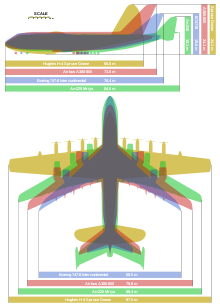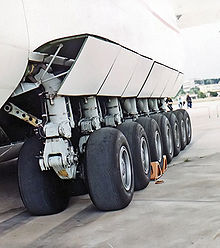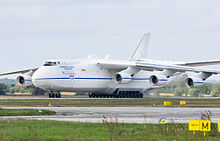- Antonov An-225
-
An-225 Mriya The An-225 with Buran atop, at the Paris Air Show in 1989. Role Strategic airlifter National origin Soviet Union / Ukraine Manufacturer Antonov First flight 21 December 1988 Status In service Primary user Antonov Airlines Produced 1988 Number built 1 Developed from Antonov An-124 The Antonov An-225 Mriya (Ukrainian: Антонов Ан-225 Мрія, Dream, NATO reporting name: 'Cossack') is a strategic airlift cargo aircraft, designed by the Antonov Design Bureau in the 1980s. It is the world's heaviest aircraft. The design, built in order to transport the Buran orbiter, was an enlargement of the successful An-124 Ruslan. The An-225's name, Mriya (Мрiя) means "Dream" (Inspiration) in Ukrainian.
The first An-225 was completed in 1988 and a second An-225 has been partially completed. The one An-225 is in commercial operation with the Antonov Airlines carrying oversized payloads.[1]
Contents
Development
 An-225 with Buran atop lands at the Paris Air Show in 1989.
An-225 with Buran atop lands at the Paris Air Show in 1989.
The Antonov An-225 was designed to airlift the Energia rocket's boosters and the Buran space shuttle for the Soviet space program. It was developed as a replacement for the Myasishchev VM-T. The An-225's original mission and objectives are almost identical to that of the United States' Shuttle Carrier Aircraft.[2]
The An-225 first flew on 21 December 1988. The aircraft was on static display at the Paris Air Show in 1989 and it flew during the public days at the Farnborough air show in 1990. Two aircraft were ordered, but only one An-225 (tail number UR-82060[3]) was finished. It can carry ultra-heavy and oversize freight, up to 250,000 kg (550,000 lb) internally,[2] or 200,000 kg (440,000 lb) on the upper fuselage. Cargo on the upper fuselage can be 70 metres (230 ft) long.[4]
A second An-225 was partially built during the late 1980s for the Soviet space program. The second An-225 included a rear cargo door and a redesigned tail with a single vertical stabilizer. It was planned to be more effective for cargo transportation.[5] Following the collapse of the Soviet Union in 1991 and the cancellation of the Buran space program, the lone operational An-225 was placed in storage in 1994.[6] The six Ivchenko Progress engines were removed for use on An-124s, and the second uncompleted An-225 airframe was also stored. The first An-225 was later re-engined and put into service.
By 2000, the need for additional An-225 capacity had become apparent, so the decision was made in September 2006 to complete the second An-225. The second airframe was scheduled for completion around 2008,[7] then delayed. By August 2009, the aircraft had not been completed and work had been abandoned.[1][8] In May 2011 Antonov CEO is reported to have said that the completion of a second An-225 Mriya transport aircraft with a carrying capacity of 250 tons requires at least $300 million, but if the financing is provided, its completion could be achieved in three years.[9]
Design
Based on Antonov's earlier An-124, the An-225 has fuselage barrel extensions added fore and aft of the wings, which received root extensions to increase span. Two more Ivchenko Progress D-18T turbofan engines were added to the new wing roots, bringing the total to six, and an increased-capacity landing gear system with 32 wheels was designed. The An-124’s rear cargo door and ramp were removed to save weight, and the empennage was changed from a single vertical stabilizer to a twin tail with an oversized horizontal stabilizer. The twin tail was essential to enable the plane to carry large, heavy external loads that would disturb the aerodynamics of a conventional tail. Unlike the An-124, the An-225 was not intended for tactical airlifting and is not designed for short-field operation.[2]
Initially the 225 had a maximum gross weight of 600 tonnes (1,320,000 lb) but the aircraft was modified in 2000–01, at a cost of US$20M, with a reinforced floor that increased the maximum gross weight to 640 tonnes (1,410,000 lb).[10][11][12]
Both the earlier and later takeoff weights establish the An-225 as the world's heaviest aircraft, being heavier than the double-deck Airbus A380 even though Airbus plans to pass the An-225's maximum landing weight with 591.7 tonnes (1,304,000 lb) for the A380.[13] The Hughes H-4 Hercules, known as the "Spruce Goose", had a greater wingspan and a greater overall height, but was 20% shorter, and due to the materials used in its construction, also lighter. In addition, the Hercules only flew once, making the An-225 the largest aircraft in the world to fly multiple times.[14] The An-225 is larger than the Airbus A380 airliner, and also bigger than the Antonov An-124, Boeing 747 Large Cargo Freighter, and Lockheed C-5 Galaxy, the nearest equivalent heavy cargo aircraft.
Operational history
In the late 1970s, efforts were begun by the Soviet government to generate revenue from its military assets. In 1989, a holding company was set up by the Antonov Design Bureau as a heavy airlift shipping corporation under the name "Antonov Airlines", based in Kiev, Ukraine and operating from London Luton Airport in partnership with Air Foyle HeavyLift.[4][15]
As the Soviet space program was in its last years, the An-225 was considered and accepted to be the prime way to transport the Buran Shuttle.
The company initiated operations with a fleet of four An-124-100s and three Antonov An-12s, but by the late 1990s a need for aircraft larger than the An-124 became apparent. In response, the original An-225 was re-engined, modified for heavy cargo transport, and placed back in service under the management of Antonov Airlines.
 Antonov An-225 at Manchester Airport in 2006
Antonov An-225 at Manchester Airport in 2006
On 23 May 2001, the An-225 received its type certificate from the Interstate Aviation Committee Aviation Register (IAC AR).[16] In September 2001, carrying 4 main battle tanks[17] at a record load of 253.82 tonnes (279.79 short tons) of cargo, the An-225 flew at an altitude of 2 km (6,600 ft) over a closed circuit of 1,000 km (620 mi) at a speed of 763.2 km/h (474.2 mph).[18]
The type's first flight in commercial service departed from Stuttgart, Germany on 3 January 2002, and flew to Thumrait, Oman with 216,000 prepared meals for American military personnel based in the region. This vast number of ready meals was transported on some 375 pallets and weighed 187.5 tons.[19]
The An-225 has since become the workhorse of the Antonov Airlines fleet, transporting objects once thought impossible to move by air, such as locomotives and 150-ton generators. It has become an asset to international relief organizations for its ability to quickly transport huge quantities of emergency supplies during disaster relief operations.[20]
Beginning in June 2003, the An-225, along with An-124s, delivered over 800 tons of equipment to aid humanitarian efforts in Iraq.[21]
The An-225 has also been contracted by the Canadian and U.S. governments to transport military supplies to the Middle East in support of Coalition forces.[20] In November 2004, FAI placed the An-225 in the Guinness Book of Records for its 240 records. An example of the cost of shipping cargo by An-225 was €266,000 for flying a chimney duct from Denmark to Kazakhstan in 2008.[22]
On 11 August 2009, the heaviest single cargo item ever sent via air freight was loaded onto the Antonov 225. At 16.23 metres (53.2 ft) long and 4.27 metres (14.0 ft) wide, the consignment–a generator for a gas power plant in Armenia and its loading frame–weighed in at a record 189.09 tonnes (416,900 lb).[23] Also during 2009, the An-225 was painted in a new blue and yellow paint scheme,[24] after Antonov ceased cooperation with AirFoyle and partnered with Volga-Dnepr in 2006.[25]
In February 2010, the An-225 transported 108 tonnes of construction machinery from Japan to Santo Domingo, Dominican Republic for quake-stricken Haiti.[26]
On 11 June 2010, the An-225 carried the world's longest piece of air cargo, when it flew two new 42-meter wind turbine blades (test subjects) from Tianjin, China to Denmark.[27]
Operators
Former operators
- Antonov Airlines for Soviet Buran program
Specifications (An-225)
 A size comparison between four of the largest aircraft, the An-225 (green), the Hughes H-4 Hercules (gold), the Boeing 747–8 (blue), and the Airbus A380-800 (pink).
A size comparison between four of the largest aircraft, the An-225 (green), the Hughes H-4 Hercules (gold), the Boeing 747–8 (blue), and the Airbus A380-800 (pink).
Data from Vectorsite,[2] Antonov's Heavy Transports[28]
General characteristics
- Crew: 6
- Payload: 250,000 kg (550,000 lb)
- Door dimensions: 440 x 640 cm (14.4 x 21 ft)
- Length: 84 m (275.6 ft)
- Wingspan: 88.4 m (290 ft 2 in)
- Height: 18.1 m (59.3 ft)
- Wing area: 905 m2 (9,743.7 ft2))
- Aspect ratio: 8.6
- Cargo Volume: 1,300 m3 (46,000 cu ft)
- Empty weight: 285,000 kg (628,315 lb)
- Max takeoff weight: 640,000 kg[10][11][12] (1,323,000 lb)
- Powerplant: 6 × ZMKB Progress D-18 turbofans, 229.5 kN (51,600 lbf) each
- Takeoff run: 3,500 m (11,500 ft) with maximum payload
Performance
- Maximum speed: 850 km/h (460 knots, 530 mph)
- Cruise speed: 800 km/h (430 knots, 500 mph)
- Range: ** With maximum fuel: 15,400 km (9,570 mi)
- With maximum payload: 4,000 km (2,500 mi))
- Service ceiling: 11,000 m (36,100 ft)
- Wing loading: 662.9 kg/m² (135.5 lb/ft²)
- Thrust/weight: 0.234
Notable appearances in media
Main article: Aircraft in fiction#Antonov An-225See also
- Related development
- Aircraft of comparable role, configuration and era
- Airbus A380-800F
- Boeing 747-8F
- Boeing 747 Shuttle Carrier Aircraft
- Lockheed C-5 Galaxy
- Myasishchev VM-T
- Related lists
References
- ^ a b "World's largest aircraft, An-225, emerges to set new lift record". Flight International, 17 August 2009.
- ^ a b c d Greg Goebel. "Antonov An-225 Mriya ("Cossack")". The Antonov Giants: An-22, An-124, & An-225. http://vectorsite.net/avantgt.html#m3. Retrieved 18 February 2006.
- ^ Photo on airliners.net
- ^ a b "Mriya". Antonov ASTC. http://www.antonov.com/products/air/transport/AN-225/index.xml. Retrieved 27 May 2004.
- ^ Kaplan, Philip. Big Wings.
- ^ Antonov An-225 Mriya. Airliners.net.
- ^ Antonov An-225 Mriya Aircraft History, Facts and Pictures. Aviationexplorer
- ^ The Mriya 2: Pictures. Buran-energia.com
- ^ "$300m needed for completion of An-225 transport, says Antonov CEO"
- ^ a b Forward, David C: Antonov's Dream Machine, p. 23. Airways magazine, June 2004
- ^ a b Spaeth, Andreas: When size matters, p. 29. Air International magazine, December 2009
- ^ a b Gordon, Yefim; Dmitriy and Sergey Komissarov: "The Six-Engined Dream", page 76. Antonov's Heavy Transports: The An-22, An-124/225 and An-70. Midland, 2004. ISBN 1857801822.
- ^ "Airbus Reveals A380-linked Pilot Systems Secrets". Flight International. 3 June 2009. http://www.flightglobal.com/articles/2009/06/03/327310/airbus-reveals-a380-linked-pilot-systems-secrets.html.
- ^ "Antonov An-225 Mryia (Cossack)". The Aviation Zone. http://www.theaviationzone.com/factsheets/an225.asp. Retrieved 2011-07-01.
- ^ "An-225 Mriya, NATO: Cossack". Goleta Air & Space Museum. http://www.air-and-space.com/Antonov%20An-225%20Mriya.htm. Retrieved 31 March 2004.
- ^ Type Certificates for Aircraft
- ^ An-225 (An-225-100) "Мрiя" Russian Aviation Museum, 20 October 2001. Retrieved: 31 October 2010.
- ^ Special planes: The Antonov-225 "Mriya". European Tribune. 8 April 2006. http://www.eurotrib.com/story/2006/4/8/13392/35796.
- ^ "Antonov Airlines:An-225 Mriya". http://www.airfoyle.co.uk/services/an225.asp.
- ^ a b "Antonov An-225". Aircraft-Info.net. Archived from the original on 1 April 2004. http://web.archive.org/web/20040401135622/http://www.aircraft-info.net/aircraft/jet_aircraft/antonov/AN-225. Retrieved 15 February 2004.
- ^ "The World’s Largest Aeroplanes". Military Zone – British Council. Archived from the original on 10 August 2004. http://web.archive.org/web/20040810032747/http://www.learnenglish.org.uk/militaryenglish/magazine/people.asp?person=86. Retrieved 14 October 2004.
- ^ Steelcon News Retrieved: 13 June 2010.
- ^ Ukraine's An-225 aircraft sets new record for heaviest single cargo item transported by air, Eye for Transport, 18 August 2009. Cargo manifest picture
- ^ Spotters.net (2009). "Photo of the AN-225 in new paint scheme". http://spotters.net.ua/files/images/0000019427_large.jpeg. Retrieved 30 December 2009.
- ^ Ingram, Frederick C. Volga-Dnepr Group answers.com. Retrieved: 24 July 2010.
- ^ "Mariya comes to the rescue". Antonov, 12 February 2010.[dead link]
- ^ Record breaking journey Renewable Energy Sources, 11 June 2010. Pictures: [1] [2] Retrieved: 13 June 2010.
- ^ Gordon, Yefim (2004). Antonov's Heavy Transports: Big Lifters for War & Peace. Midland Publishing. ISBN 1-85780-182-2.
External links
- Official An-225 web page
- An-225 – buran-energia.com
- An-225 – YouTube.com The worlds biggest planes: Antonov An-225 in comparison with Airbus A380-800, Airbus A340-600 and Boeing 747-400
- Second Antonov An-225 Mriya (line no. 01-02) under construction at Aviant-Kiev Aviation Plant. Kiev-Svyatoshino (UKKT), Ukraine, 19 September 2004
- Second Antonov An-225 Mriya (line no. 01-02) (front view) under construction at Aviant-Kiev Aviation Plant. Kiev-Svyatoshino (UKKT), Ukraine, 20 August 2008
- Second Antonov An-225 Mriya (line no. 01-02) (side view) under construction at Aviant-Kiev Aviation Plant. Kiev-Svyatoshino (UKKT), Ukraine, 20 August 2008
- Payloads
- An-225 (An-225-100) "Мрiя", Antonov OKB (NATO Cossack)
Antonov aircraft Airliners Transports Reconnaissance and surveillance Experimental An-13 · SKVGliders Unknown An-204Giant aircraft Production Aero Spacelines Super Guppy · Airbus A380-800 · Airbus Beluga · Antonov An-124 Ruslan · Antonov An-225 Mriya · Convair B-36 · Boeing 747 (SP/-400/-8I/8F/LCF) · Martin JRM Mars · Lockheed C-5 Galaxy
Prototypes Blohm & Voss BV 238 · Bristol Brabazon · Convair XC-99 · Hughes H-4 Hercules · Lockheed R6V Constitution · Saunders-Roe Princess
Concepts ProposedAbandonedWingless aircraft Luftschiffbau Zeppelin Hindenburg class (airship) · Fairey Rotodyne · Goodyear ZPG-3W (blimp) · Mil Mi-12 (helicopter)
Aircraft designed for the carriage of outsized cargo In service Beluga · Largo Cargo Freighter · Mriya · Super Guppy
Retired Lists relating to aviation General Aircraft (manufacturers) · Aircraft engines (manufacturers) · Airlines (defunct) · Airports · Civil authorities · Museums · Registration prefixes · Rotorcraft (manufacturers) · TimelineMilitary Accidents/incidents Records Categories:- Antonov aircraft
- Shuttle Buran program
- Soviet cargo aircraft 1980–1989
- Six-engined aircraft
Wikimedia Foundation. 2010.






